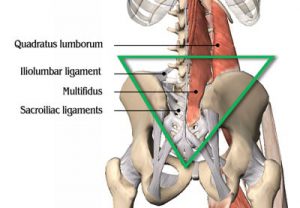
Last week while flipping TV channels, I happened to catch some interesting gossip from a cheesy entertainment show reporting that Stefani Germanotta, aka Lady Gaga, was being treated for low-back pain at a local physical therapy clinic. This uniquely talented, five-time Grammy Award winner and self- proclaimed “high heeled queen of sheen” has probably done more to mess up low backs than anyone since Mike Tyson. So, here she is at the ripe age of 25 suffering back spasm.
Although high heels have been in and out of vogue since Catherine of Medici invented them in Paris, France, in the 16th century, I’ve always been puzzled by the strange attraction to body height— which figures, since I was always the tall one in class. I’d somehow missed the point, so I decided to pose the question to my wife. She said, “Erik, some women would grow their toenails long and walk on them if they thought it’d make them look sexier.”
That answer certainly didn’t settle my curiosity, so I searched online for some fashion-magazine photos of high-heeled ladies, studied the postures and finally arrived at three seemingly logical visual advantages gained from wearing high heels: curvier hips and a more prominent buttock occur due to exaggerated lumbar lordosis; legs appear longer and leaner as the thoracic spine hyperextends to compensate for the swayed low back; and the female chest becomes more prominent as the shoulder girdle is driven back by the hyperextended thorax.
Creating a new dynamic equilibrium
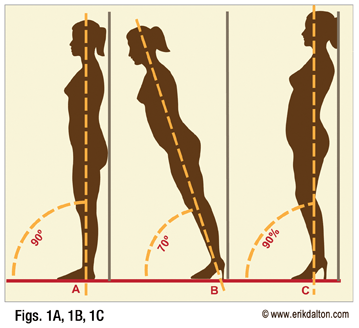
The biomechanical effect of heels, in everything from running shoes to stilettos, has puzzled researchers and fired controversy for almost a century. In a highly functioning body, the neuro-myoskeletal system hangs in dynamic equilibrium, each part balancing the other. But when a woman wears high heels, a new dynamic equilibrium occurs. If one body part becomes fixed, the whole system must compensate with altered movement patterns, resulting in kinetic “chain” kinks.
Here is an interesting experiment that will help you get a feel for the biomechanical adjustments high-heel wearers deal with every day:
Stand barefoot with the back against a wall. Observe how your upright body column forms a perpendicular line, or 90-degree angle, with the floor (Fig. 1a). Slide a 2-inch wedge of some kind, such as a phone book, under both heels. Notice by keeping your body column rigid, you’re forced to tilt forward from 90 to about 70 degrees (Fig. 1b).
Now replace the wedge with a 3-inch wedge and straighten up so you’re touching the wall again. Feel the dramatic myoskeletal adaptations that take place. Can you feel your ankles shift from dorsi- to plantar-flexion? In this standing posture, the knees buckle, hips flex, low back sways and shoulder girdle retracts (Fig. 1c).
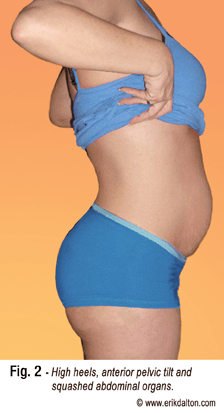
The brain, guided by foot, ankle and visual proprioceptors, must instantaneously make a whole series of myofascial and joint adjustments to the ankle, knee, hip, spine and head to regain and retain erect stance and equilibrium.
But high-heeled, posturo-functional faults are not confined to the external milieu; they may also inflict compressional damage on the internal viscera, particularly the pelvic bowl contents. According to research conducted by Canadian physiotherapist Diane Lee, which she described in the article, “Biomechanical Effects of Wearing HIGH HEEL SHOES,” published in the International Journal of Industrial Ergonomics, excessive lumbar lordosis causes the pelvic bowl to dip anteriorly, which raises the body’s center of gravity and leads to reduced proprioceptive stability. So not only are we more unstable on our feet when wearing heels, but the increased anterior pelvic tilt squashes our poor organs.
For example, when standing barefoot, the anterior angle, or pelvic tilt, of the female pelvis is 25 degrees; on low, 1-inch heels it increases to 30 degrees; on 2-inch heels it increases to 45 degrees; and on 3-inch heels it increases to 60 degrees. You don’t have to be a physicist to envision how increased heel height causes gravity to compress and distort abdominal organs (Fig. 2). (Hopefully, one day we’ll see a well-designed study testing the relationship of long-term high-heel wearing to gut problems, such as prolapsed colons, distended bladders and hemorrhoids.)
Heel-wedge angle and ball-walking
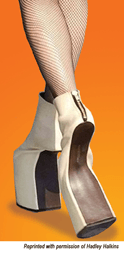
The actual term researchers use to describe the slope, or slant, of the heel, rear to front, is called the heel-wedge angle—so, the higher the heel, the greater the angle. For instance, during our barefoot wall-standing experiment, we could feel how our body weight was shared equally between the heel and ball of the foot. We also observed how increasing the heel-wedge angle caused our weight to shift forward in proportion to the increase.
Biomechanically, when wearing a low heeled shoe, body weight is shared approximately 40 percent by the heel and 60 percent by the ball. Amazingly, the simple act of switching to a high-heeled shoe causes weight to shift to 90 percent borne by the ball and 10 percent by the heel.
It looks like Lady Gaga’s 9-inch stilettos completely eliminate the need for an anatomical heel. My guess is the higher she jacked up the heel, the more ball-walking she was doing—and she soon realized there was really no need for a heel at all. That’s probably all it took to launch her designers into a frenzy to create heelless shoe styles, such as the pair shown above.
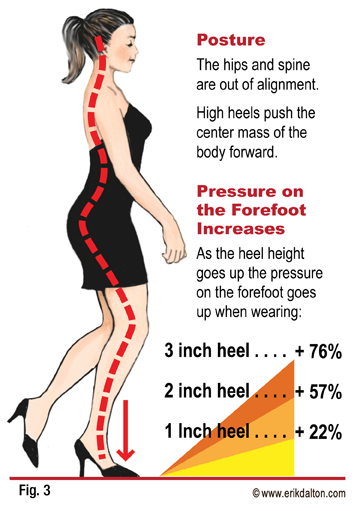
As the trained eye observes posturomovement mechanics of ball walking, it’s easy to see how these foot and ankle weight shifts mess up the normal barefoot walking sequence of heel-to-ball-to-toe-to push off. Once the heels are elevated 3 inches or more, little weight is borne by the heel, which causes the push-off phase to arise almost wholly from the ball (Fig. 3).
Daily high-heeled cyclical loading forces the brain to rethink and remap normal ingrained motor control patterns. When compensations are sustained over prolonged periods through habitual wearing of heels, tissues, such as gastroc, soleus and Achilles tendon, shorten and begin adhering to neighboring fascial structures (Fig. 4).
The propulsive power thief
Many women love to wear high heels—and, I might add, many men like women in high heels. However, it’s true some women, like Lady Gaga, suffer for their vanities. In young women, this is accommodated by ankle and hip mobility and low-back stability. But many high-heel wearing women find as they age and their hip joints stiffen, shock waves shoot through the lumbar spine and cause disc compression, ligamentous laxity and facet joint spurring.
Women should be cautious about wearing heels constantly, or over long periods of time. Clearly, the human foot was not designed to walk in stilettos—or cowboy boots, for that matter. The foot is specifically constructed to land in a heel-to-toe, rolling motion whereby the arch, ankle and knee absorb shock, or stored energy, and release the ground reaction force up the kinetic chain to counter-rotate the torso and pelvis.
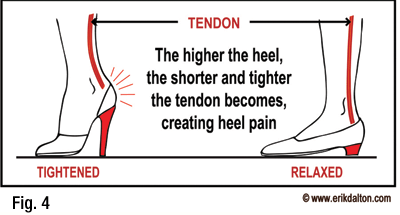
As we saw in our demonstrations, the heeled shoe steals this propulsive power from tendons, ligaments and leg muscles. Not only do heels place the foot and leg under greater stress to achieve the demands of propulsion, but the borrowed power must be leeched from higher structures in the kinetic chain, including the knees, thigh muscles, hips and trunk. As a small army of anatomical reinforcements are recruited to rescue the handicapped fascial tissues, the body continues to lose energy to the ground.
Heels of any height set in motion a series of gait-negative consequences, making natural gait—meaning the barefoot form—impossible. Don’t let your clients be a slave to fashion; fix their feet and give them back the natural spring in their step.
References
- Carrier, D.R., Cunningham, C.B., Schilling, N., and Anders, C., “The influence of foot posture on the cost of transport in humans.” J. Exp. Biol., 213, 790-797, 2010.
- Bramble, D.M, and Lieberman, D.E. “Endurance running and the evolution of Homo.” Nature, 432, 345–352 (2004).

On sale this week only!
Save 25% off the "Dalton Technique Treasures" eCourse
The “Dalton Technique Treasures” eLearning course is a compilation of some of Erik’s favorite Myoskeletal Alignment Techniques (MAT). Learn MAT techniques to assess and address specific sports injuries, structural misalignment, nervous system overload, and overuse conditions. ON SALE UNTIL July 29th! Get Lifetime Access: As in all our eLearning courses, you get easy access to the course online and there is no expiry date.





